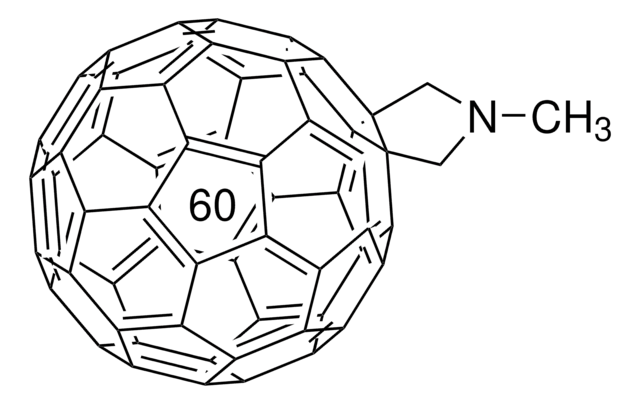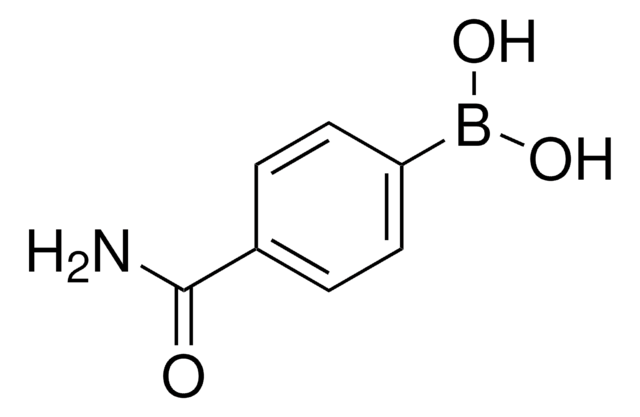Kluczowe dokumenty
684503
[6,6]-Pentadeuterophenyl C61 butyric acid methyl ester
99.5%, 99.5 atom % D
Synonim(y):
1-[3-(Methoxycarbonyl)propyl]-1-pentadeuterophenyl-[6.6] C61, 3′-(Phenyl-d5) 3′H-cyclopropyl[1,9] [5,6]fullerene-C60-Ih-3′-butanoic acid methyl ester, d5-PCBM
About This Item
Polecane produkty
opis
functionalized fullerene
czystość izotopowa
99.5 atom % D
Próba
99.5%
Postać
powder
przesunięcie masy
M+5
ciąg SMILES
[2H]c1c([2H])c([2H])c(c([2H])c1[2H])C2(CCCC(=O)OC)[C]3=4c5c6c7c8c9c%10c(c%11c%12c3c%13c5c%14c%15c6c%16c7c%17c9c%18c%19c%10c%20c%11c%21c%12c%22c%13c%23c%14c%24c%15c%25c%16c%26c%17c%18c%27c%28c%19c%20c%29c%21c%30c%22c%23c%31c%24c%32c%25c%26c%27c%33c%28c%29c%30c%31c%32%33)[C]2=48
InChI
1S/C72H14O2/c1-74-11(73)8-5-9-70(10-6-3-2-4-7-10)71-66-58-50-40-30-22-14-12-13-16-20-18(14)26-34-28(20)38-32-24(16)25-17(13)21-19-15(12)23(22)31-37-27(19)35-29(21)39-33(25)43-42(32)52-46(38)56-48(34)54(44(50)36(26)30)62(66)64(56)68-60(52)61-53(43)47(39)57-49(35)55-45(37)51(41(31)40)59(58)67(71)63(55)65(57)69(61)72(68,70)71/h2-4,6-7H,5,8-9H2,1H3/i2D,3D,4D,6D,7D
Klucz InChI
FIGVSQKKPIKBST-QRKCWBMQSA-N
Opis ogólny
Zastosowanie
Hasło ostrzegawcze
Warning
Zwroty wskazujące rodzaj zagrożenia
Zwroty wskazujące środki ostrożności
Klasyfikacja zagrożeń
Eye Irrit. 2 - Skin Irrit. 2 - STOT SE 3
Organy docelowe
Respiratory system
Kod klasy składowania
11 - Combustible Solids
Klasa zagrożenia wodnego (WGK)
WGK 3
Temperatura zapłonu (°F)
Not applicable
Temperatura zapłonu (°C)
Not applicable
Środki ochrony indywidualnej
dust mask type N95 (US), Eyeshields, Gloves
Wybierz jedną z najnowszych wersji:
Masz już ten produkt?
Dokumenty związane z niedawno zakupionymi produktami zostały zamieszczone w Bibliotece dokumentów.
Klienci oglądali również te produkty
Produkty
Since the first publication in 1995 describing a bulk heterojunction photodiode incorporating a methanofullerene, significant progress has been made in improving device performance and the scope of device research has broadened widely.
PCBM-based n-type semiconductors - Find p- and n-type organic semiconductors available from Sigma-Aldrich with PCBM library & properties.
Find various photovoltaic and bioscience-based applications of fullerenes.
Znajdź różne zastosowania fulerenów w fotowoltaice i naukach biologicznych.
Nasz zespół naukowców ma doświadczenie we wszystkich obszarach badań, w tym w naukach przyrodniczych, materiałoznawstwie, syntezie chemicznej, chromatografii, analityce i wielu innych dziedzinach.
Skontaktuj się z zespołem ds. pomocy technicznej
![[6,6]-Phenyl C61 butyric acid methyl ester ≥99%](/deepweb/assets/sigmaaldrich/product/structures/359/221/d990c746-0960-4c69-bf76-fe09b193824d/640/d990c746-0960-4c69-bf76-fe09b193824d.png)
![4-(1′,5′-Dihydro-1′-methyl-2′H-[5,6]fullereno-C60-Ih-[1,9-c]pyrrol-2′-yl)benzoic acid](/deepweb/assets/sigmaaldrich/product/structures/417/736/540e4dd8-0c87-48e5-8307-3befb16498ba/640/540e4dd8-0c87-48e5-8307-3befb16498ba.png)


![[6,6]-Phenyl C71 butyric acid methyl ester, mixture of isomers 99%](/deepweb/assets/sigmaaldrich/product/structures/716/624/9fb9f2f0-ae99-429f-8d3a-b12267976a4d/640/9fb9f2f0-ae99-429f-8d3a-b12267976a4d.png)
![[6.6] Diphenyl C62 bis(butyric acid methyl ester)(mixture of isomers) 99.5%](/deepweb/assets/sigmaaldrich/product/structures/213/478/93c26667-6556-40bb-8cbe-350bdbabfc00/640/93c26667-6556-40bb-8cbe-350bdbabfc00.png)


